Health and Economic Impact Assessment of Transport and Industry PM2.5 Control Policy in Guangdong Province
Abstract
:1. Introduction
2. Methodology
2.1. Integrated Model Structure
2.1.1. CGE Model
2.1.2. GAINS Model
2.1.3. Health Analysis Module
2.2. Datebase
2.2.1. Current Situation of Energy Consumption and GDP in Guangdong Province
2.2.2. PM2.5 Emissions in Guangdong Province
2.2.3. Population and Labor Force
3. Scenario Description and Setting
4. Results and Analysis
4.1. Quality of Air Pollutants Based on GAINS Model
4.2. Emission Sector Analysis
4.3. Health Impact
4.4. Macro-Economic Impact
4.5. Cost-Benefit Analysis
4.6. Uncertainty Analysis
5. Discussion
6. Conclusions
- (1)
- Compared with the WOC scenario, the BLK and AIC scenarios implemented more strict air control strategies, and the total volume of PM2.5 emission in 2025 will drop by 46.9% and 63.9%, respectively. The cement sector declines the most, decreasing by 63.1% and 81.4%, respectively. In 2035, PM2.5 emissions fall by 50% and 79.9%, respectively. The cement sector is still the sector with the largest decline, falling by 64.3% and 91.5%, respectively.
- (2)
- The incidence rate of the WOC scenario is about 240 cases/10,000 persons. The incidence rate of the AIC and BLK scenarios is 150 cases/10,000 persons and 140 cases/10,000 persons in 2035, respectively. In addition, premature deaths will be 70,000 and 40,000 in 2035 for the two scenarios, respectively. Due to the control of pollutants, the early death rate decreases by 33.0% and 37.5%, respectively, and the health effect improve.
- (3)
- Furthermore, improved labor force quality induced by better air conditions promotes increased added value in labor-intensive industries such as agriculture (0.233%), other manufacturing (0.172%), textiles (0.181%), food (0.176%), railway transport (0.137%), and services (0.129%). The added value declines in the waste (−0.073%), natural gas (−0.076%), and crude oil sectors (−0.072%) because more PM2.5 treatment equipment requires greater investment.
Author Contributions
Funding
Institutional Review Board Statement
Informed Consent Statement
Data Availability Statement
Conflicts of Interest
Appendix A
| Impact Category | ERFs | C.I. (95%) Low | C.I. (95%) High |
|---|---|---|---|
| Chronic mortality | 0.40% | 0.03% | 0.80% |
| Respiratory hospital admissions | 1.17 × 10−5 | 6.38 × 10−6 | 1.72 × 10−5 |
| Cerebrovascular hospital admission | 8.40 × 10−6 | 6.47 × 10−7 | 1.16 × 10−5 |
| Cardiovascular hospital admissions | 7.23 × 10−6 | 3.62 × 10−6 | 1.09 × 10−5 |
| Chronic bronchitis | 4.42 × 10−5 | −1.82 × 10−6 | 9.02 × 10−5 |
| Asthma attacks | 1.22 × 10−4 | 4.33 × 10−5 | 12.08 × 10−4 |
| Respiratory symptoms days | 2.50 × 10−2 | 2.17 × 10−1 | 4.05 × 10−1 |
| work loss day | 2.07 × 10−2 | 1.76 × 10−2 | 2.38 × 10−2 |
| Sectors | 2020 | 2025 | 2030 | 2035 |
|---|---|---|---|---|
| Agriculture | 5.59 | 6.56 | 6.09 | 5.65 |
| Power generation | 48.87 | 48.91 | 46.50 | 44.22 |
| Petroleum mining | 0.06 | 0.01 | 0.00 | 0.00 |
| Natural gas mining | 2.95 | 3.03 | 1.63 | 0.88 |
| Other mining | 1.67 | 1.97 | 2.04 | 2.11 |
| Food manufacturing | 5.34 | 5.97 | 5.72 | 5.48 |
| Textile | 5.04 | 5.27 | 4.42 | 3.71 |
| Wood processing | 1.69 | 1.76 | 1.69 | 1.64 |
| Papermaking | 9.44 | 10.28 | 10.91 | 11.59 |
| Other manufacturing | 6.71 | 7.12 | 6.65 | 6.22 |
| Oil refining | 12.09 | 14.44 | 16.29 | 18.38 |
| Coking | 11.53 | 8.83 | 2.69 | 0.82 |
| Chemical industry | 27.93 | 33.32 | 37.78 | 42.85 |
| Cement | 11.92 | 12.44 | 12.67 | 12.90 |
| Other non-metallic manufacturing industry | 10.59 | 11.78 | 10.13 | 8.71 |
| Glass manufacturing | 4.18 | 4.50 | 3.70 | 3.04 |
| Ceramic manufacturing | 3.47 | 3.97 | 3.65 | 3.37 |
| Steel | 74.75 | 89.20 | 106.91 | 128.13 |
| Non-ferrous metal smelting | 7.43 | 9.04 | 9.86 | 10.76 |
| Metalware | 8.95 | 10.03 | 10.22 | 10.41 |
| Mechanical manufacturing | 11.09 | 12.27 | 12.78 | 13.30 |
| Electronic equipment manufacturing | 16.51 | 15.57 | 13.79 | 12.21 |
| Gas production and supply | 1.01 | 1.12 | 1.01 | 0.92 |
| Water production and supply | 2.00 | 2.29 | 2.52 | 2.77 |
| Construction | 3.88 | 4.43 | 4.54 | 4.65 |
| Road transport | 1.81 | 2.17 | 2.22 | 2.28 |
| Railway transportation | 9.38 | 11.58 | 11.71 | 11.84 |
| Urban public transport | 7.39 | 10.48 | 10.66 | 10.84 |
| Water transport | 10.64 | 12.59 | 11.45 | 10.41 |
| Air transport | 11.17 | 13.40 | 15.64 | 18.24 |
| Other transportation | 0.07 | 0.08 | 0.07 | 0.06 |
| Service industry | 18.06 | 22.90 | 25.35 | 28.05 |
| Total | 353.20 | 397.31 | 411.30 | 436.42 |
References
- XINHUANET. Remarks by Chinese President Xi Jinping at Climate Ambition Summit. 2020. Available online: http://www.xinhuanet.com/english/2020-12/12/c_139584803 (accessed on 12 December 2020).
- 2018 Report on the State of Guangdong Provincial Ecology and Environment; Guangdong Provincial Department of Ecology and Environment: Guangzhou, China, 2018. Available online: http://gdee.gd.gov.cn/hjzkgb/content/post_2466184 (accessed on 17 May 2019).
- Zivin, J.G.; Neidell, M. The Impact of Pollution on Worker Productivity. Am. Econ. Rev. 2012, 102, 3652–3673. [Google Scholar] [CrossRef] [Green Version]
- Hanna, R.; Oliva, P. The Effect of Pollution on Labor Supply: Evidence from a Natural Experiment in Mexico City. J. Public Econ. 2015, 122, 68–79. [Google Scholar] [CrossRef] [Green Version]
- Kan, H.D.; Chen, B.H. Particulate air pollution in urban areas of Shanghai, China: Health-based economic assessment. Sci. Total Environ. 2004, 322, 71–79. [Google Scholar] [CrossRef] [PubMed]
- Zhang, D.; Aunan, K.; Seip, H.M.; Larssen, S.; Liu, J.; Zhang, D. The assessment of health damage caused by air pollution and its implication for policy making in Taiyuan, Shanxi, China. Energy Policy 2010, 38, 491–502. [Google Scholar] [CrossRef] [Green Version]
- Huang, D.; Xu, J.; Zhang, S. Valuing the health risks of particulate air pollution in the Pearl River Delta, China. Environ. Sci. Policy 2012, 15, 38–47. [Google Scholar] [CrossRef]
- The Cost of Air Pollution: Strengthening the Economic Case for Action; World Bank, Washington. 2016. Available online: https://www.wdronline.worldbank.org/handle/10986/25013 (accessed on 8 September 2016).
- Huang, D.; Zhang, S. Health benefit evaluation for PM2.5 pollution control in Beijing-Tianjin-Hebei region of China. China Environ. Sci. 2013, 33, 166–174. [Google Scholar]
- Matus, K.; Nam, K.-M.; Selin, N.E.; Lamsal, L.N.; Reilly, J.M.; Paltsev, S. Health damages from air pollution in China. Glob. Environ. Chang. Hum. Policy Dimens. 2012, 22, 55–66. [Google Scholar] [CrossRef] [Green Version]
- Matus, K.; Yang, T.; Paltsev, S.; Reilly, J.; Nam, K.-M. Toward integrated assessment of environmental change: Air pollution health effects in the USA. Clim. Chang. 2008, 88, 59–92. [Google Scholar] [CrossRef]
- Burniaux, J.M.; Chateau, J. An Overview of the OECD ENV-Linkages Model. OECD 2008, 2009, 267–289. [Google Scholar] [CrossRef]
- Ravina, M.; Panepinto, D.; Zanetti, M. Air quality planning and the minimization of negative externalities. Resources 2019, 8, 15. [Google Scholar] [CrossRef] [Green Version]
- Qi, C.A.; Yu, L.B.C.; Ali, T.; Ji, G.E.; Hao, C.A. Economic and climate impacts of reducing China’s renewable electricity curtailment: A comparison between CGE models with alternative nesting structures of electricity. Energy Econ. 2020, 91, 104892. [Google Scholar]
- Xie, Y.; Dai, H.; Dong, H.; Hanaoka, T.; Masui, T. Economic Impacts from PM2.5 Pollution-Related Health Effects in China: A Provincial-Level Analysis. Environ. Sci. Technol. 2016, 50, 4836–4843. [Google Scholar] [CrossRef] [PubMed]
- Wu, R.; Dai, H.; Yong, G.; Xie, Y.; Masui, T.; Liu, Z.; Qian, Y. Economic Impacts from PM2.5 Pollution-Related Health Effects: A Case Study in Shanghai. Environ. Sci. Technol. 2017, 51, 5035–5042. [Google Scholar] [CrossRef]
- Wang, P.; Dai, H.C.; Ren, S.Y.; Zhao, D.Q.; Masui, T. Achieving Copenhagen target through carbon emission trading: Economic impacts assessment in Guangdong Province of China. Energy 2015, 79, 212–227. [Google Scholar] [CrossRef]
- Tohka, A. The GAINS Model for Greenhouse Gases—Version 1.0: HFC, PFC and SF6; IR-05-056; IIASA: Laxenburg, Austria, 2005; Available online: http://pure.iiasa.ac.at/7782 (accessed on 12 December 2020).
- Bickel, P.; Friedrich, R.; Franke, B.; Bachmann, T.M.; Gressmann, A.; Rabl, A.; Hunt, A.; Markandya, A.; Tol, R.S.; Hurley, F.; et al. ExternE Externalities of Energy Methodology 2005 Update; European Communities: Luxembourg, 2004. [Google Scholar]
- Li, S. Input Output Table of China’s Regional Expansion in 2007: Compilation and Application; Economic Science Press: Beijing, China, 2007. (In Chinese) [Google Scholar]
- Pope, C.A.; Burnett, R.T.; Thun, M.J.; Calle, E.E.; Krewski, D.; Ito, K.; Thurston, G.D. Lung cancer, cardiopulmonary mortality, and long-term exposure to fine particulate air pollution. JAMA J. Am. Med. Assoc. 2002, 287, 1132–1141. [Google Scholar] [CrossRef] [PubMed] [Green Version]
- Chen, B.H.; Hong, C.J.; Kan, H.D. Exposures and health outcomes from outdoor air pollutants in China. Toxicology 2004, 198, 291–300. [Google Scholar] [CrossRef] [PubMed]
- Burnett, R.T.; Pope, C.A.; Ezzati, M.; Olives, C.; Lim, S.S.; Mehta, S.; Shin, H.H.; Singh, G.; Hubbell, B.; Brauer, M.; et al. An Integrated Risk Function for Estimating the Global Burden of Disease Attributable to Ambient Fine Particulate Matter Exposure. Environ. Health Perspect. 2014, 122, 397–403. [Google Scholar] [CrossRef] [PubMed]
- Chen, R.; Kan, H.; Chen, B.; Huang, W.; Bai, Z.; Song, G.; Pan, G.; Grp, C.C. Association of Particulate Air Pollution with Daily Mortality. Am. J. Epidemiol. 2012, 175, 1173–1181. [Google Scholar] [CrossRef]
- Pope, C.A.; Burnett, R.T.; Thurston, G.D.; Thun, M.J.; Calle, E.E.; Krewski, D.; Godleski, J.J. Cardiovascular mortality and long-term exposure to particulate air pollution—Epidemiological evidence of general pathophysiological pathways of disease. Circulation 2004, 109, 71–77. [Google Scholar] [CrossRef] [Green Version]
- Apte, J.S.; Marshall, J.D.; Cohen, A.J.; Brauer, M. Addressing Global Mortality from Ambient PM2.5. Environ. Sci. Technol. 2015, 49, 8057–8066. [Google Scholar] [CrossRef]
- Guangdong Statistical Yearbook 2018; Statistics Bureau of Guangdong Province: Guangzhou, China, 2019. Available online: http://stats.gd.gov.cn/gdtjnj/content/post_1424903.html (accessed on 29 October 2018).
- Hammer, M.S.; Donkelaar, A.V.; Li, C.; Lyapustin, A.; Martin, R.V. Global Estimates and Long-Term Trends of Fine Particulate Matter Concentrations (1998–2018). Environ. Sci. Technol. 2020, 54, 7879–7890. [Google Scholar] [CrossRef] [PubMed]
- 2013 Report on the State of Guangdong Provincial Ecology and Environment; Guangdong Provincial Department of Ecology and Environment: Guangzhou, China, 2013. Available online: http://gdee.gd.gov.cn/hjzkgb/content/post_2335526.html (accessed on 5 June 2014).
- 2014 Report on the State of Guangdong Provincial Ecology and Environment; Guangdong Provincial Department of Ecology and Environment: Guangzhou, China, 2014. Available online: http://gdee.gd.gov.cn/hjzkgb/content/post_2335527 (accessed on 4 June 2015).
- 2015 Report on the State of Guangdong Provincial Ecology and Environment; Guangdong Provincial Department of Ecology and Environment: Guangzhou, China, 2015. Available online: http://gdee.gd.gov.cn/hjzkgb/content/post_2335528 (accessed on 8 June 2016).
- 2016 Report on the State of Guangdong Provincial Ecology and Environment; Guangdong Provincial Department of Ecology and Environment: Guangzhou, China, 2016. Available online: http://gdee.gd.gov.cn/hjzkgb/content/post_2335529 (accessed on 15 June 2017).
- 2017 Report on the State of Guangdong Provincial Ecology and Environment; Guangdong Provincial Department of Ecology and Environment: Guangzhou, China, 2017. Available online: http://gdee.gd.gov.cn/hjzkgb/content/post_2335530 (accessed on 4 June 2018).
- Delfino, R.J.; Sioutas, C.; Malik, S. Potential role of ultrafine particles in associations between airborne particle mass and cardiovascular health. Environ. Health Perspect. 2005, 113, 934–946. [Google Scholar] [CrossRef] [PubMed] [Green Version]
- Burnett, R.; Chen, H.; Fann, N.; Hubbell, B.; Pope, C.A.; Apte, J.S.; Brauer, M.; Cohen, A.; Weichenthal, S.; Coggins, J. Global estimates of mortality associated with long-term exposure to outdoor fine particulate matter. Proc. Natl. Acad. Sci. USA 2018, 115, 201803222. [Google Scholar] [CrossRef] [PubMed] [Green Version]
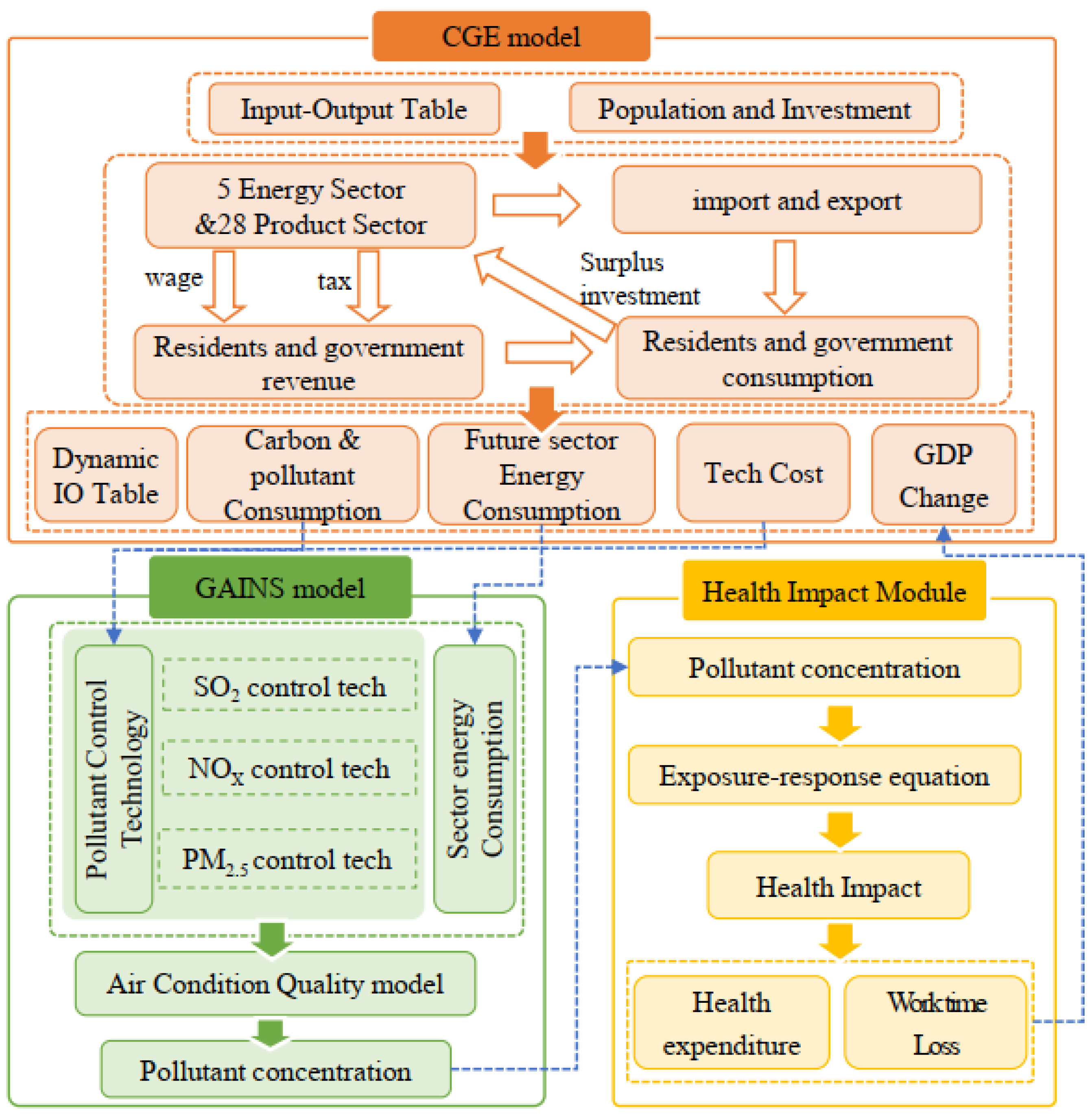

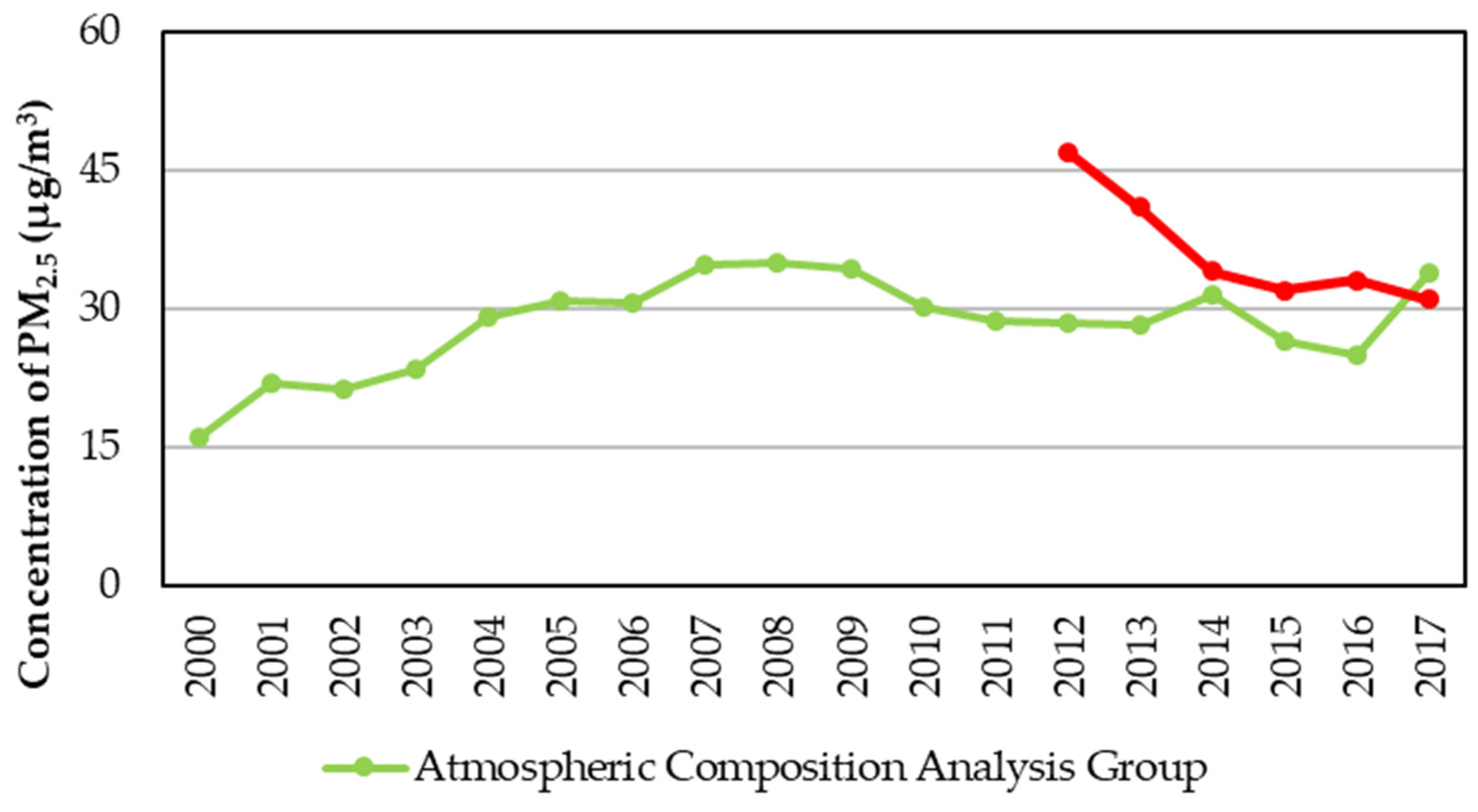

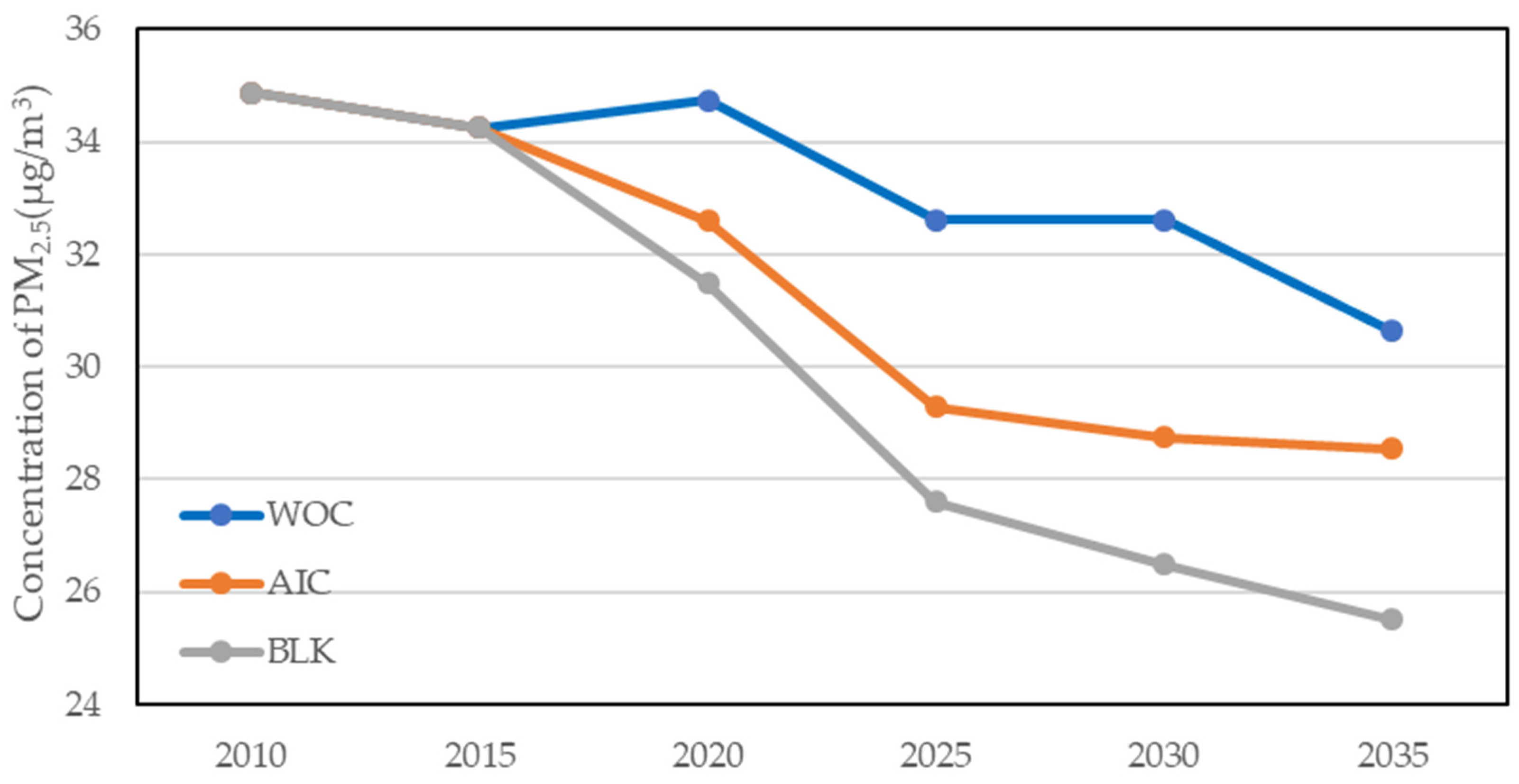
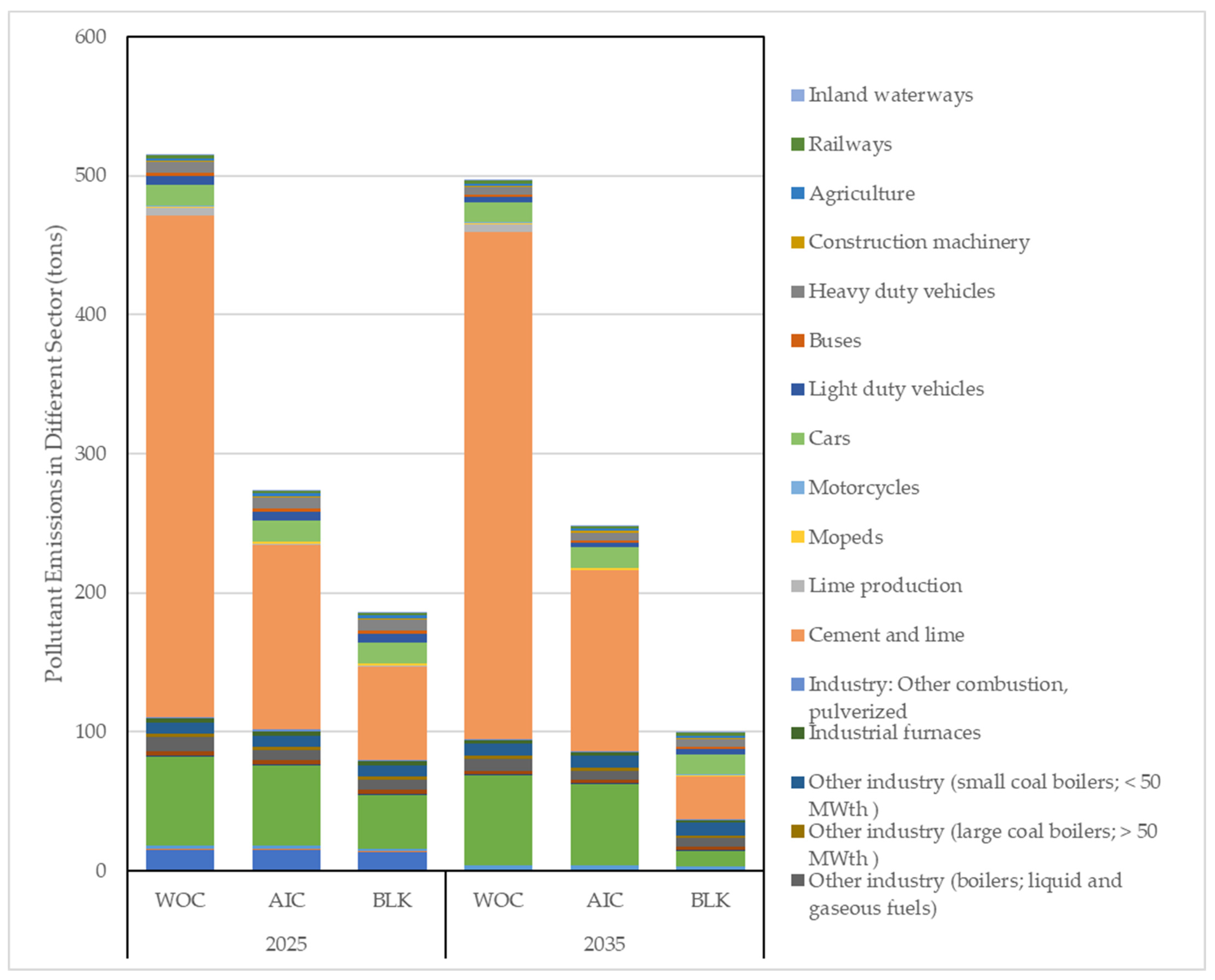
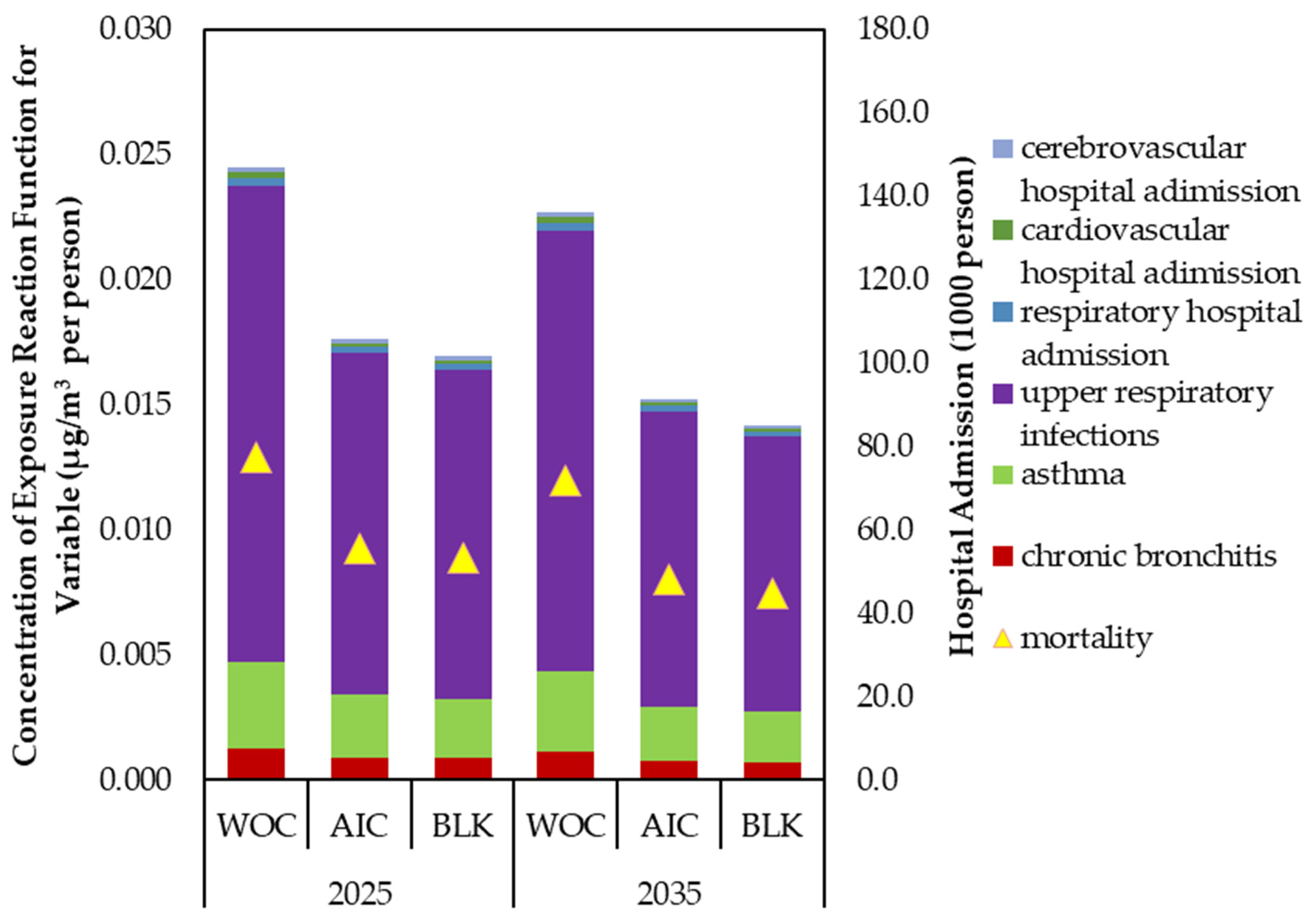
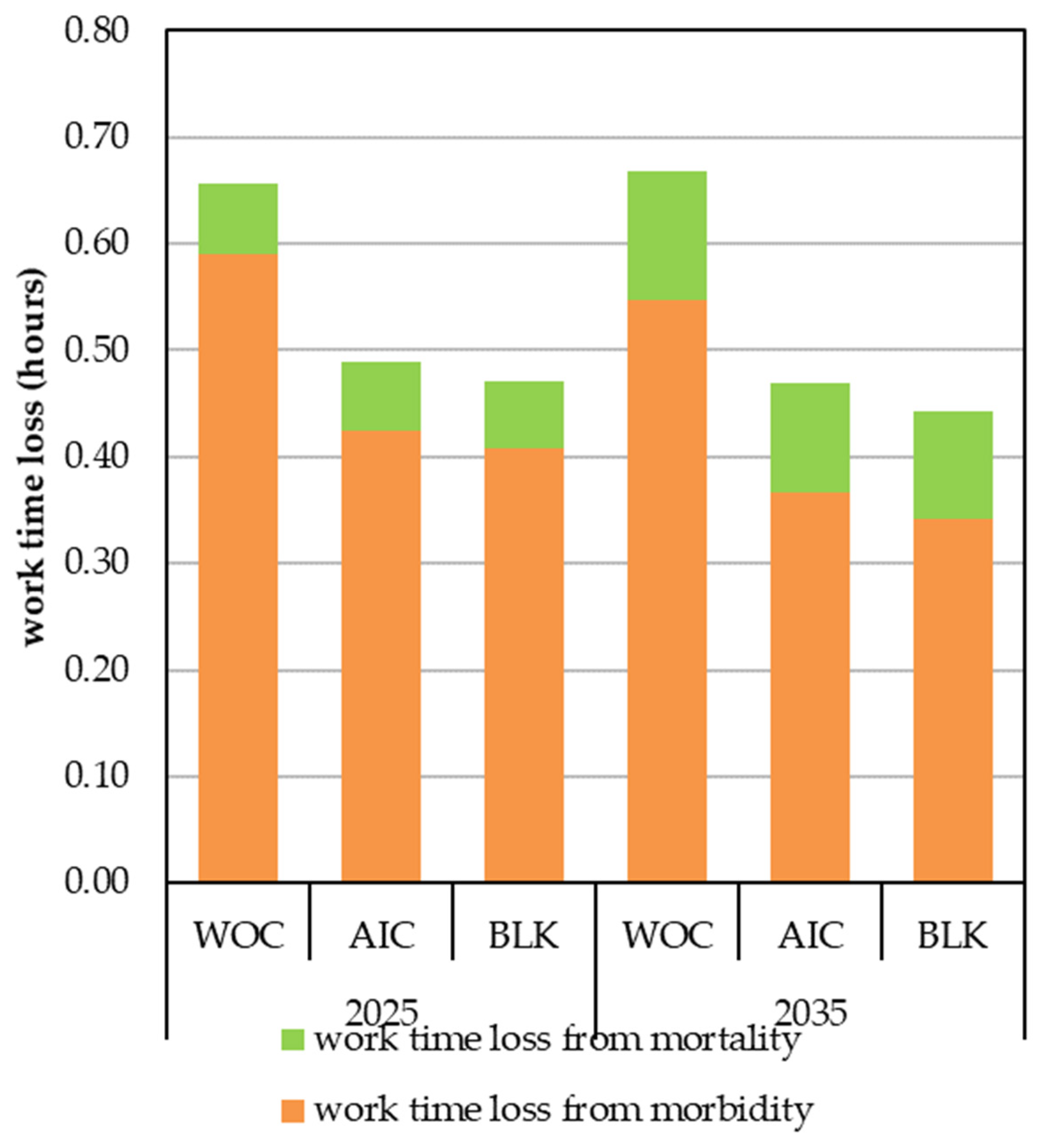

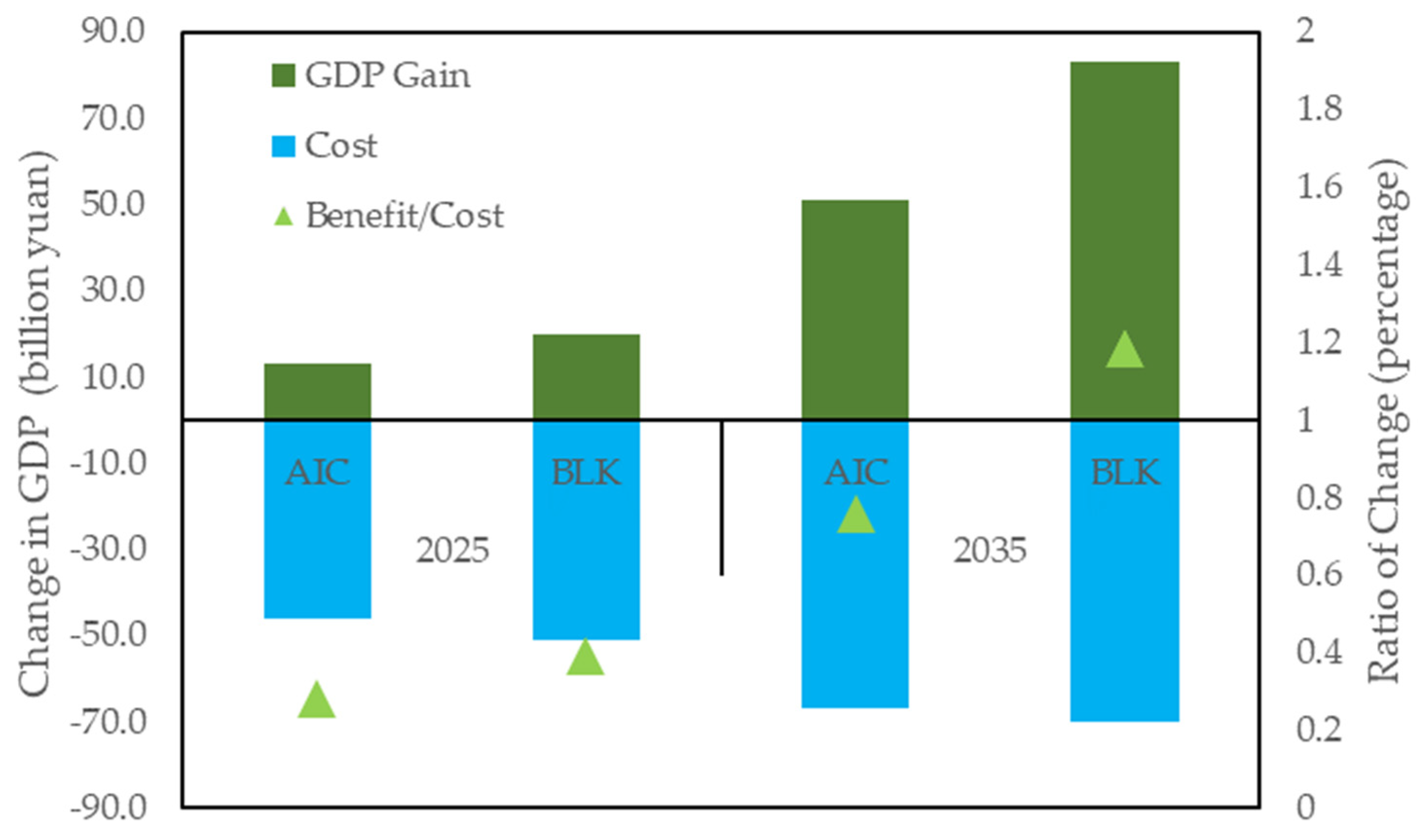
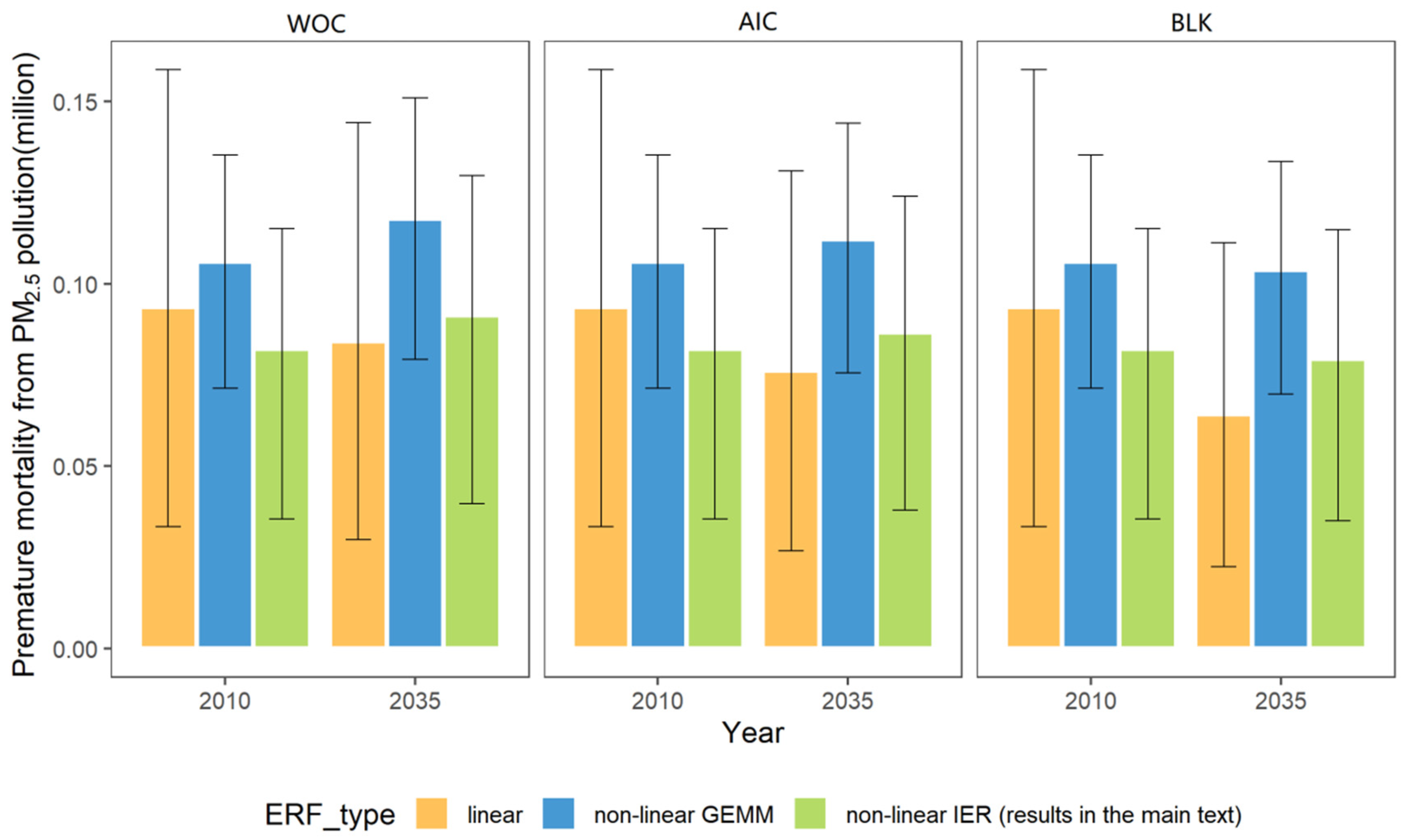
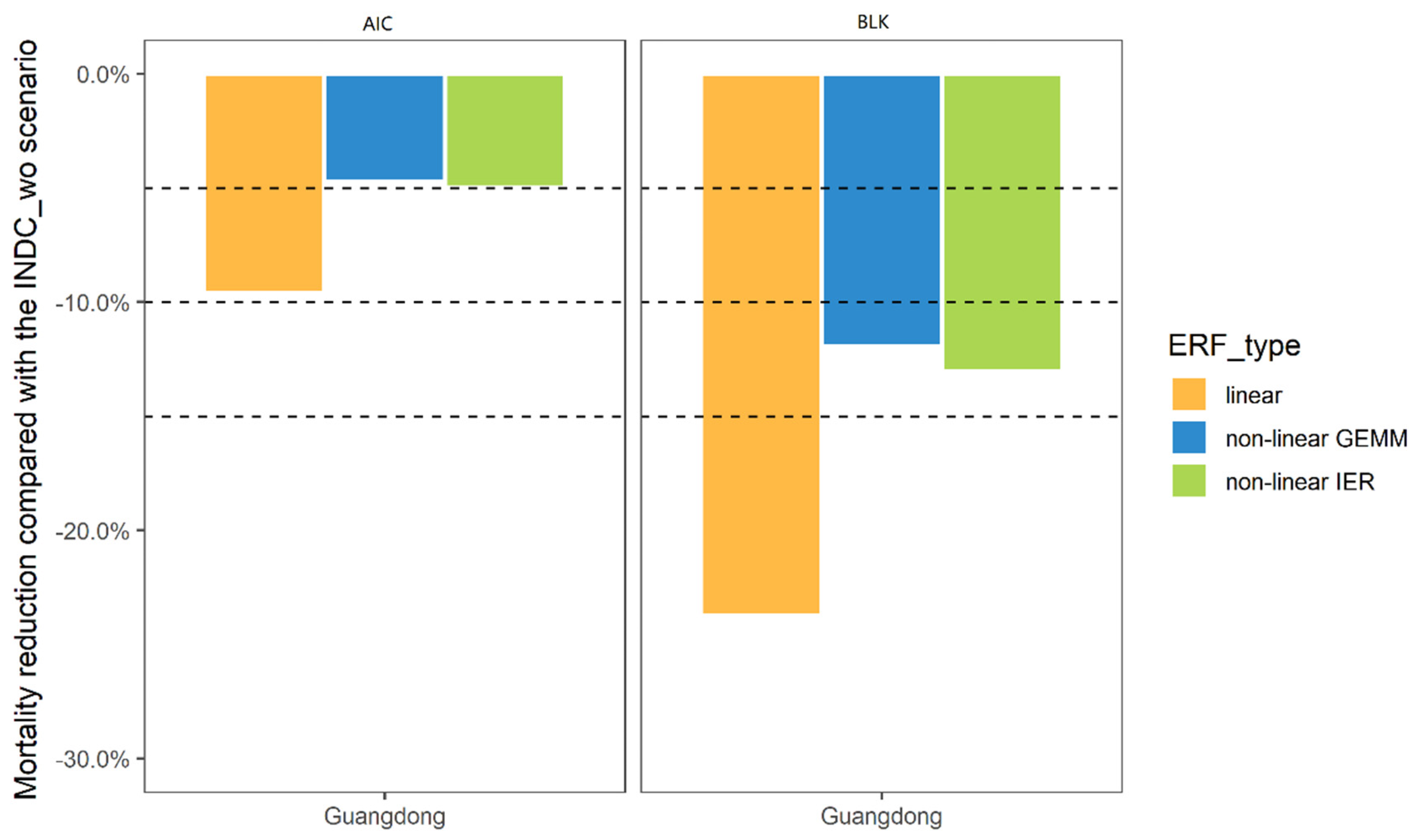
| No. | Sector Name | No. | Sector Name |
|---|---|---|---|
| 1 | Agriculture | 18 | Steel |
| 2 | Coal mining | 19 | Non-ferrous metal smelting |
| 3 | Petroleum mining | 20 | Metalware |
| 4 | Natural gas mining | 21 | Mechanical manufacturing |
| 5 | Other mining | 22 | Electronic equipment manufacturing |
| 6 | Food manufacturing | 23 | Power generation |
| 7 | Textile | 24 | Gas production and supply |
| 8 | Wood processing | 25 | Water production and supply |
| 9 | Papermaking | 26 | Construction |
| 10 | Other manufacturing | 27 | Road transport |
| 11 | Oil refining | 28 | Railway transportation |
| 12 | Coking | 29 | Urban public transport |
| 13 | Chemical industry | 30 | Water transport |
| 14 | Cement | 31 | Air transport |
| 15 | Other non-metallic manufacturing industry | 32 | Other transportation |
| 16 | Glass manufacturing | 33 | Service industry |
| 17 | Ceramic manufacturing |
| Scenario Name | CGE Model Parameter Setting: GDP Growth Rate | CGE Parameter Setting | GAINS Parameter Setting Description: Industry | GAINS Parameter Setting Description: Transport |
|---|---|---|---|---|
| WOC | In the years of 2015 to 2020, the GDP growth rate is set as 7%; in the years of 2020 to 2030 and 2030 to 2035, the GDP growth rate is set as 6% and 5.5% according to the economic development plan. | Considering the carbon emission constraint target policy for Guangdong: Toward 2030 achieving INDC target, CO2 intensity reduced by 60–65% | Considering health impact of the labor force. Until 2035, the air control strategy is same as in 2015. (1) The existing coal-fired boiler adopts electric dust removal equipment which maintains the status quo. (2) the newly added boiler is also the same as the existing boiler using the same electric dust removal equipment | (1) For the different vehicles in road transport, the EURO 3 level standard on light duty spark ignition for road vehicles is adopted. (2) Consider more electric vehicles being adopted at low speeds of 5%. |
| AIC | Air control strategy is moderate. (1) The penetration rate of electric dust removal equipment for existing coal-fired boilers has reached more than 80%, and the removal rate has reached more than 96%. (2) The newly-added boiler adopts high-efficiency electric dust removal equipment, and the dust removal efficiency has reached more than 99%. | (1) By 2035, using Stage 2 control technology on heavy duty vehicles, and executing the EURO 4 level standard on light duty spark ignition road vehicles. (2) Consider that more electric vehicles are adopted at medium speed of 10%. | ||
| BLK | Air control strategy is strict. (1) PM2.5 concentration reaches WHO level II (25 μg/m3). (2) By 2035, industry PM2.5 removal efficiency is 99%. | (1) Using Stage 3 pollution control technology on heavy duty vehicles. (2) Implement EURO 5 standard on light duty for spark ignition road vehicles. (3) Considering the adoption of more electric vehicles at high speed of 20%. |
| GDP Gains (%) | Welfare Gains (%) | |||||
|---|---|---|---|---|---|---|
| Lower | Medium | Upper | Lower | Medium | Upper | |
| AIC | 0.2 | 0.05 | 1.28 | 0.2 | 0.28 | 0.37 |
| BLK | 0.35 | 0.11 | 0.36 | 0.26 | 0.36 | 0.46 |
| 2015 | 2020 | 2025 | 2030 | 2035 | |
|---|---|---|---|---|---|
| WOC | 394.97 | 442.76 | 441.31 | 426.15 | 400.89 |
| AIC | 394.97 | 503.38 | 501.73 | 492.16 | 464.69 |
| BLK | 394.97 | 523.01 | 589.72 | 616.56 | 639.08 |
Publisher’s Note: MDPI stays neutral with regard to jurisdictional claims in published maps and institutional affiliations. |
© 2021 by the authors. Licensee MDPI, Basel, Switzerland. This article is an open access article distributed under the terms and conditions of the Creative Commons Attribution (CC BY) license (https://creativecommons.org/licenses/by/4.0/).
Share and Cite
Ren, S.; Wang, P.; Dai, H.; Zhao, D.; Masui, T. Health and Economic Impact Assessment of Transport and Industry PM2.5 Control Policy in Guangdong Province. Sustainability 2021, 13, 13049. https://doi.org/10.3390/su132313049
Ren S, Wang P, Dai H, Zhao D, Masui T. Health and Economic Impact Assessment of Transport and Industry PM2.5 Control Policy in Guangdong Province. Sustainability. 2021; 13(23):13049. https://doi.org/10.3390/su132313049
Chicago/Turabian StyleRen, Songyan, Peng Wang, Hancheng Dai, Daiqing Zhao, and Toshihiko Masui. 2021. "Health and Economic Impact Assessment of Transport and Industry PM2.5 Control Policy in Guangdong Province" Sustainability 13, no. 23: 13049. https://doi.org/10.3390/su132313049
APA StyleRen, S., Wang, P., Dai, H., Zhao, D., & Masui, T. (2021). Health and Economic Impact Assessment of Transport and Industry PM2.5 Control Policy in Guangdong Province. Sustainability, 13(23), 13049. https://doi.org/10.3390/su132313049





